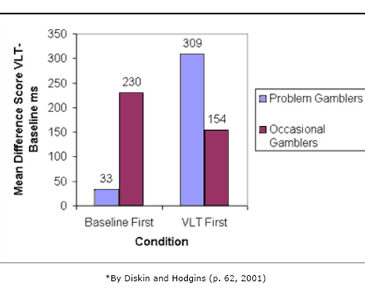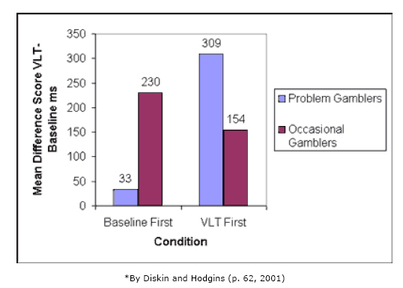Some video lottery players report that they are oblivious to their surroundings when playing (Wynne, 1994). In a new study, Diskin and Hodgins (2001) explore problem (i.e., level 2) versus occasional gamblers’ response time to external light stimuli when playing a video lottery game.
Forty-two experienced video lottery terminal (VLT) players (i.e., problem and non problem gamblers as identified by the South Oaks Gambling Screen; SOGS; Lesieur & Blume, 1987) participated in one of two research conditions: Baseline First and VLT First. The Baseline First condition required that participants respond to light stimuli, controlled by the researchers, atop a covered VLT for five minutes. Participants subsequently were asked to play the VLT, uncovered, for an additional twenty minutes while responding to controlled light stimuli. In the VLT First condition, the response tasks were reversed. Research participants played the uncovered VLT for twenty minutes while responding to the controlled light stimuli and then responded to light stimuli atop a covered VLT for five minutes. Response to light stimuli in both conditions was measured by an I/O counter timer board. Difference scores were used as the dependent variable to control for individual differences in reaction speed.1
Diskin and Hodgins (2001) hypothesize that problem gamblers-if they dissociate from their environmental context-would be slower to respond to external light stimuli than occasional gamblers when playing the VLT. However, the data do not support this hypothesis. Analyses do show, however, that the order in which problem gamblers engage in the research conditions (i.e., Baseline first, VLT second; VLT first, Baseline second) influences their response time to light stimuli. Specifically, when the research condition order is VLT first and Baseline second, it takes problem gamblers twice a long as occasional gamblers to respond to light stimuli when playing the VLT. Conversely, when Baseline precedes VLT play, ". . .problem gamblers were almost seven times faster than the occasional gamblers to respond to the lights during the VLT task" (Diskin and Hodgins, 2001, p. 62). Indeed, there is a significant main effect of Condition (p=.031) and a significant Group by Condition interaction (p<.001; see Figure 1). No significant relationship exists between task order and the response time of occasional gamblers.
*By Diskin and Hodgins (p. 62, 2001)
Diskin and Hodgins (2001) have provided exploratory insight into the dissociative experience of problem gamblers. Indeed, their finding that it takes problem gamblers twice a long as occasional gamblers to respond to light stimuli when playing the VLT before the Baseline condition suggests that problem gamblers might be more focused on the gambling experience than occasional gamblers. However, the results also show that problem gamblers’ response time to light stimuli is almost seven times faster than that of occasional gamblers when the Baseline condition precedes the VLT condition; this finding suggests that problem gamblers might be conforming to the expectations of the research experiment and consequently shifting their focus away from the VLT and to the light stimuli (Diskin and Hodgins, 2001).
There are methodological questions that emerge from the Diskin and Hodgins’ (2001) research. Data are drawn from a sample of VLT players only. Consequently, the study findings might not generalize to level 1 and 2 gamblers who engage in other gambling activities (e.g., craps, poker, bingo, and slot machines). Diskin and Hodgins (2001) also admit that the problem gamblers in their study are actually designated probable pathological gamblers based on their SOGS scores. This classification schema was chosen, according to Diskin and Hodgins (2001), because there is some debate over the probable pathological designation. However, classifying gamblers by criteria they might not fully meet on the grounds that there is debate over these criteria is methodologically precarious. Nevertheless, Diskin and Hodgins (2001) have illustrated the need to further examine the characteristics of the response and focus of level 1, 2, and 3 gamblers while gambling as well as the clinical and treatment implications that such research might yield. Moreover, Diskin and Hodgins (2001) have thoughtfully raised the issue of whether gamblers are any more absorbed in their gambling compared with others who are focused on their interests (e.g., the artist absorbed in painting, the child absorbed in eating an ice cream cone, or the researcher captivated by data analysis).
1 Difference scores were calculated by subtracting research participants’ mean baseline reaction time from their mean VLT reaction time (Diskin and Hodgins, 2001).
References
Diskin, K. M., & Hodgins, D. C. (2001). Narrowed focus and dissociative experiences in a community sample of experienced video lottery gamblers. Canadian Journal of Behavioural Science, 33(1), 58-64.
Lesieur, H. R., & Blume, S. B. (1987). The South Oaks Gambling Screen (SOGS): a new instrument for the identification of pathological gamblers. American Journal of Psychiatry, 144, 1184-1188.
Wynne, H. (1994). A description of problem gamblers in Alberta: a secondary analysis of the gambling and problem gambling in Alberta study. Edmonton: Alberta Alcohol and Drug Abuse Commission.
The WAGER is a public education project of the Division on Addictions at Harvard Medical
School. It is funded, in part, by the National Center for Responsible Gaming, the
Massachusetts Department of Public Health, the Addiction Technology Transfer Center of
New England, the Substance Abuse and Mental Health Services Administration, and the
Center for Substance Abuse Treatment.





